Comprehensive Analysis of EMI Shielding Spiral Tube Liners: Customer Concerns, Potential Issues, and Solutions
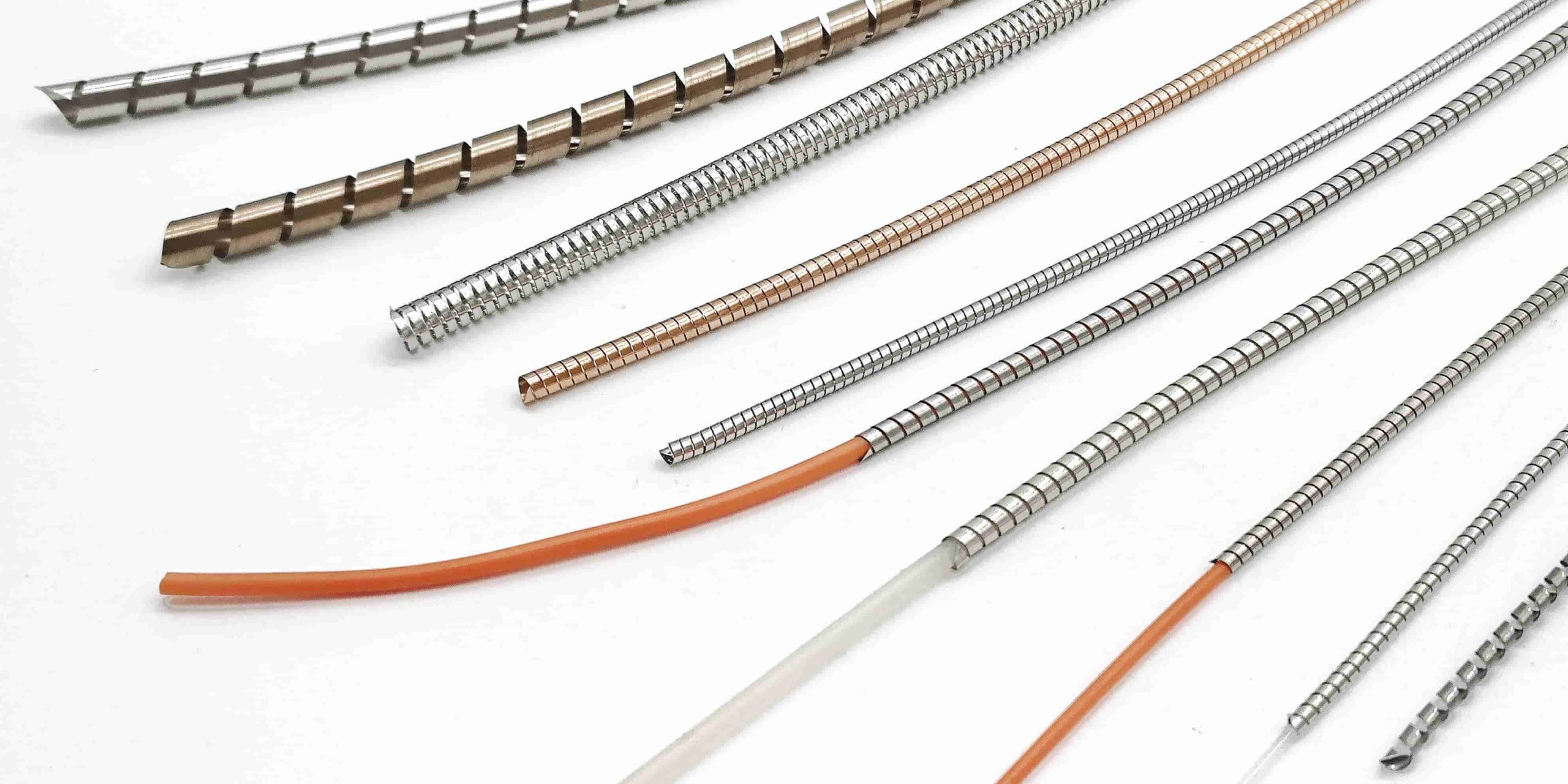
EMI Shielding Spiral Tube Liners-Handashielding
목차
1. Introduction
Electromagnetic interference (EMI) is an ever-present challenge in today’s advanced electronic systems. As devices become increasingly compact and operate at higher frequencies, the need for effective EMI shielding has never been greater. One critical element in the shielding landscape is the spiral tube liner—a specialized gasket designed to provide both EMI shielding and grounding. By forming continuous, conductive contact paths, these liners help ensure that sensitive electronic equipment remains protected from disruptive electromagnetic fields.
This comprehensive analysis delves into the details of EMI shielding spiral tube liners. It addresses customer concerns encountered during procurement, potential issues that may arise in practical applications, and corresponding countermeasures. By integrating insights from leading industry sources such as 한다 차폐, this article serves as a definitive guide for engineers, technicians, and procurement specialists. The following sections explore the fundamental design and functionality of these liners, outline specific product model recommendations (including those found on handashielding.com), and provide an in-depth discussion of technical challenges alongside robust solutions.
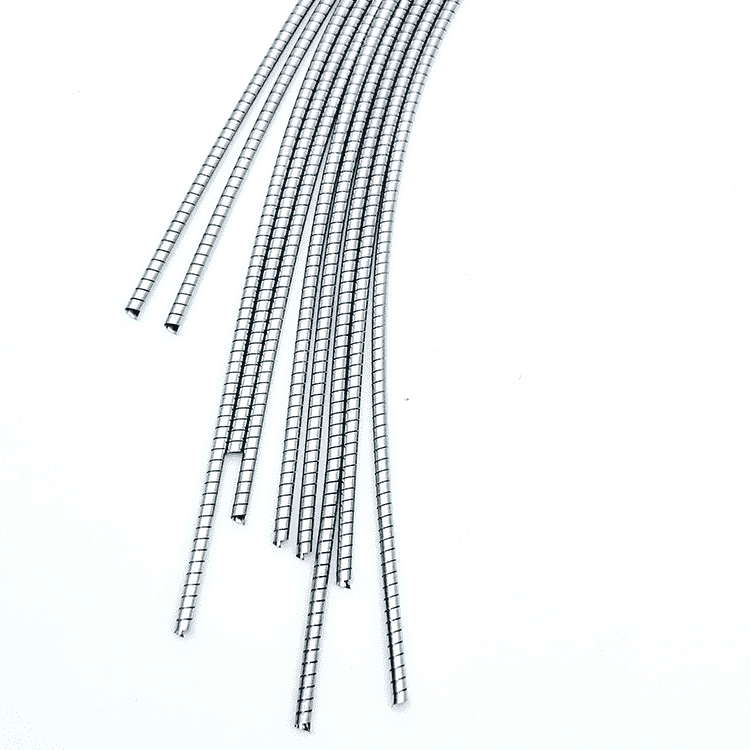
2. Overview of EMI Shielding Spiral Tube Liners
2.1 Definition and Importance
EMI shielding spiral tube liners are conductive gaskets that are engineered to form continuous, circular contact rings within electronic enclosures. Their primary function is to block and reflect unwanted electromagnetic radiation, thus ensuring that high-frequency signals do not interfere with the performance of sensitive circuits. In many high-end applications—ranging from 5G communications to aerospace systems—the integrity of signal transmission and the prevention of interference are critical. Spiral tube liners achieve this by providing a robust electrical connection between the housing and the internal components, thereby creating an effective barrier against EMI.
The growing complexity of electronic systems and the increasing density of circuit boards have made the reliability of EMI shielding more significant than ever before. This makes spiral tube liners a vital component in modern electronic designs, where even minor lapses in shielding integrity can lead to significant performance degradation or system failures.
2.2 Materials and Manufacturing Techniques
The performance of a spiral tube liner is largely determined by its material composition and manufacturing process. The most common materials used include:
- 베릴륨 구리(BeCu): Favored for its high electrical conductivity, excellent mechanical properties, and fatigue resistance. When plated with tin, its corrosion resistance is further enhanced, making it ideal for high-frequency applications.
- 스테인리스 스틸: Often used in applications where cost is a critical factor. Although it offers lower electrical conductivity than BeCu, stainless steel liners can still provide adequate shielding performance in lower-frequency environments (typically below 1 GHz).
Manufacturing Techniques
- Stamping and Extrusion: The predominant method for forming spiral tube liners involves stamping or extruding the chosen alloy into the desired spiral shape. This process ensures consistent thickness and dimensions.
- Edge Finishing: Post-production, the edges are carefully finished to eliminate any sharp corners or burrs that might compromise the electrical connection or mechanical durability.
- 표면 처리: To further improve the performance of the liner, surface treatments such as plating (tin plating is common for BeCu) or coating with a protective layer (e.g., silicone rubber) are applied. These treatments enhance corrosion resistance and ensure that the conductive surface remains pristine over extended periods of use.
2.3 Product Variants and Model Suggestions
Manufacturers such as Handa Shielding offer a variety of spiral tube liners tailored to specific applications. For example:
- High-End Models for Military and Aerospace: These often use tin-plated beryllium copper (e.g., the SS/MS series) to achieve superior shielding performance—up to 165 dB in broadband applications for frequencies above 1 GHz.
- Cost-Effective Options for Commercial Electronics: Stainless steel liners (e.g., the NI series) are popular in consumer and commercial applications. Despite being less expensive, they can still deliver a shielding effectiveness of over 95 dB at 1 GHz.
- Composite Designs for Dual-Requirement Applications: For applications demanding both high-frequency shielding and environmental sealing (such as in aerospace), D-type multi-layer shielding liners combine BeCu spiral tubes with an outer silicone rubber layer. This hybrid design ensures not only EMI protection but also enhanced hermeticity.
The specific model suggestions and series nomenclature (such as “NC” to denote the absence of an inner core in certain models) are guided by the product ranges available on Handa Shielding’s website. These models are engineered to meet diverse performance, cost, and installation requirements.
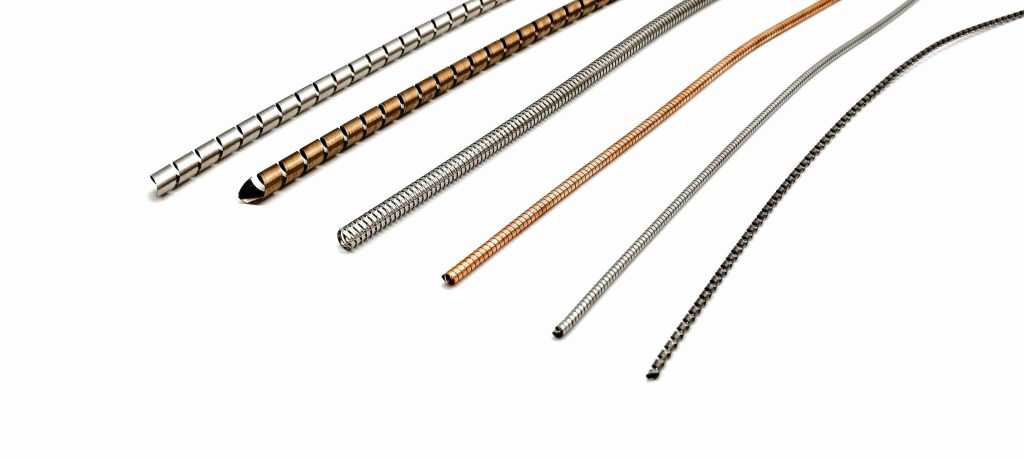
3. Customer Main Concerns and Corresponding Solutions
In the procurement and application of EMI shielding spiral tube liners, customers often express several key concerns. In this section, we discuss these concerns in detail and provide actionable solutions based on technical insights and industry best practices.
3.1 Shielding Effectiveness and Frequency Adaptability
Concern:
Customers frequently question whether a chosen spiral tube liner will deliver adequate EMI shielding performance in both high-frequency (e.g., 5G, millimeter-wave) and low-frequency (e.g., industrial equipment) scenarios. They are particularly concerned about the influence of material selection on the frequency response.
Solution:
- High-Frequency Applications:
For applications operating above 1 GHz, the recommendation is to use a tin-plated beryllium copper spiral tube liner. Tin plating enhances the corrosion resistance while maintaining the excellent conductive properties of BeCu. In high-frequency scenarios, these liners can achieve shielding effectiveness values as high as 165 dB over a broad frequency range. Models from the SS/MS series (referencing Handa Shielding’s product range) are specifically designed for such demanding environments. - Low-Frequency Applications:
In environments where the operating frequency is lower (e.g., below 1 GHz), stainless steel spiral tube liners offer an economical yet effective solution. Although stainless steel has lower conductivity compared to BeCu, its performance at 1 GHz is typically sufficient, with shielding effectiveness exceeding 95 dB. The NI series is an excellent example, balancing cost and performance for commercial electronics. - Composite or Hybrid Solutions:
For applications requiring simultaneous high-frequency shielding and environmental sealing (as in aerospace or military equipment), a D-type multi-layer shielding liner is recommended. This design combines the superior EMI shielding of a tin-plated BeCu spiral tube with an outer layer of silicone rubber. The silicone layer not only contributes to hermetic sealing but also provides additional mechanical protection, ensuring that the system maintains both its EMI integrity and environmental durability.
Technical Note: Shielding performance is determined by several parameters including material conductivity, contact pressure, and the physical design of the liner. By carefully selecting materials and tailoring the design to match the operating frequency, designers can ensure optimal performance even under challenging conditions.
3.2 Cost and Performance Trade-Offs
Concern:
A recurring issue in the selection process is balancing high-performance requirements against cost constraints. Beryllium copper is an expensive material, and customers with limited budgets may opt for lower-cost alternatives. However, they worry that these alternatives might not deliver the required high-frequency shielding performance.
Solution:
- Tiered Selection Strategy:
- For Civil and Commercial Applications:
The NI series, which uses stainless steel, is typically prioritized for non-critical applications where cost savings are essential. Despite its lower price point, these liners provide robust performance for many commercial electronics. - For Military and Aerospace Applications:
High-end projects requiring maximum shielding effectiveness and reliability should opt for the SS/MS series based on tin-plated beryllium copper. These products, although more expensive, are engineered to meet stringent performance standards.
- For Civil and Commercial Applications:
- Custom Design Options:
Customization plays a pivotal role in optimizing cost without compromising performance. For example, models can be tailored to include or exclude an inner core based on compression requirements. The addition of an “NC” (no core) option can help reduce material costs and weight while still delivering satisfactory EMI performance. - Value Engineering:
Through the adoption of a tiered product strategy and custom design solutions, customers can achieve an optimal balance between performance and cost. This approach allows for targeted investment in critical areas while economizing on less demanding applications.
3.3 Installation Complexity and Structural Adaptability
Concern:
Installation is a critical factor affecting overall system reliability. Customers often worry about the complexity of installing spiral tube liners—especially when the design involves groove-type mounting, which may require high machining precision. There is also concern that the liners could easily detach if mounted improperly, particularly in surface-mounted configurations.
Solution:
- Optimized Groove Design:
An optimal groove design is essential for ensuring that the liner remains securely in place. Research and practical experience indicate that a dovetail (or “finger-lock”) groove design outperforms a straight groove configuration. The dovetail groove prevents the liner from dislodging by offering mechanical interlocking, with the groove height set to approximately 75% of the liner’s height and a width that allows for both compression and expansion. This design recommendation has been validated in numerous industrial applications. - Simplified Mounting Techniques:
In addition to optimized groove designs, alternative mounting methods such as adhesive backing or clip-on structures can reduce the need for screw fixation. These methods not only simplify installation but also improve the overall maintainability of the device. For instance, using high-performance conductive adhesives can provide secure bonding without compromising the electrical integrity of the contact surfaces. - Installation Guidelines and Training:
Comprehensive installation guidelines, coupled with technician training programs, can further mitigate installation challenges. Clear instructions regarding alignment, compression limits, and environmental considerations ensure that the spiral tube liners are installed correctly the first time, thereby reducing the likelihood of installation-related failures.
3.4 Long-term Reliability and Environmental Resistance
Concern:
EMI shielding components must perform reliably over long periods—even in harsh environments. Customers often express concerns regarding the potential for corrosion, permanent deformation, or degradation in performance due to exposure to humidity, salt-spray, or vibration.
Solution:
- Enhanced Material Treatments:
For improved long-term reliability, selecting a tin-plated beryllium copper liner is advisable. The tin plating not only boosts conductivity but also significantly enhances resistance to salt-spray and electrochemical corrosion. This treatment is particularly critical in marine, aerospace, and industrial environments where corrosive agents are prevalent. - Environmental Sealing Layers:
In applications where environmental protection is paramount, the addition of an outer silicone rubber or other elastomeric sealing layer is recommended. This outer layer acts as a barrier against moisture, chemicals, and dust, thereby prolonging the lifespan of the conductive liner. Hybrid designs that combine the EMI shielding properties of BeCu with the environmental resistance of silicone rubber are especially effective. - Regular Inspection and Maintenance:
Establishing a routine inspection and maintenance schedule is essential to ensure ongoing performance. Periodic checks can help identify early signs of wear, corrosion, or deformation, allowing for timely intervention before significant degradation occurs. - Design for Durability:
Incorporating design features that accommodate thermal expansion, vibration damping, and mechanical stress can further enhance the long-term reliability of the liner. Advanced finite element analysis (FEA) can be employed during the design phase to simulate environmental stress and optimize the component accordingly.
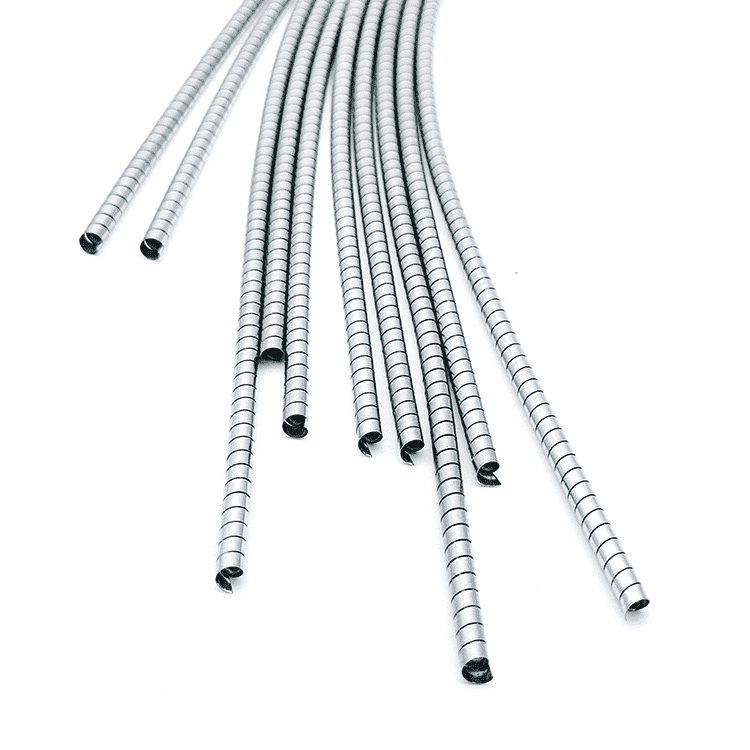
4. Potential Issues of Spiral Tube Liners and Countermeasures
Despite careful design and material selection, certain potential issues may arise during the use of spiral tube liners. Understanding these issues and implementing appropriate countermeasures is critical for ensuring sustained performance.
4.1 Over-Compression Damage
Issue:
Excessive compression during installation or operation can lead to irreversible deformation of the spiral tube liner. This is particularly a risk for stainless steel models, where over-compression can compromise the mechanical integrity and electrical continuity, thereby reducing shielding effectiveness.
Countermeasures:
- Pressure-Limiting Structural Design:
Incorporate design features such as limit grooves that physically restrict the compression range. For example, models like MS-04 that include a PVC inner core are designed to limit the compression to a safe range—typically between 5% and 30%. - Elastic Matching:
Select among standard, medium, or low elasticity variants (such as SS, MS, and LS series) based on the application’s specific elastic requirements. This ensures that the applied compression remains within acceptable limits and prevents excessive mechanical stress. - Installation Monitoring:
Use torque-limited tools during installation to prevent the application of excessive force. Additionally, real-time monitoring of the compression during assembly can provide valuable feedback to technicians, ensuring adherence to design specifications.
4.2 High Frequency Shielding Performance Fluctuations
Issue:
Stainless steel liners, while economical, may exhibit reduced shielding performance at frequencies above 1 GHz. This drop in effectiveness can pose significant challenges in applications where high-frequency EMI is a concern.
Countermeasures:
- Mixed Material Use:
A practical solution is to employ a mixed-material strategy. High-frequency sensitive areas can utilize tin-plated beryllium copper liners, while less critical, lower-frequency regions use stainless steel liners. This approach optimizes both performance and cost. - Rigorous Testing and Verification:
Require suppliers to provide comprehensive shielding performance test reports that cover the intended frequency range (for example, 1–10 GHz). Such documentation ensures that the product meets all necessary performance standards before deployment. - Design Optimization:
Refine the liner design (e.g., finger shape, spacing, and surface finish) to enhance high-frequency performance. Iterative design improvements, validated through simulation and practical testing, can help reduce performance fluctuations over the desired frequency range.
4.3 Poor Electrical Contact and Leakage Risks
Issue:
Insufficient cleaning or oxidation of the installation surfaces can lead to increased contact resistance. This may result in RF leakage, undermining the EMI shielding performance of the assembly.
Countermeasures:
- Pre-Installation Surface Treatment:
Ensure that all installation surfaces are thoroughly cleaned using a high-quality conductive cleaner before assembly. This process removes any oxides, contaminants, or residual lubricants that could impair electrical contact. - Enhanced Multi-Point Grounding:
In critical applications, incorporate multi-point grounding techniques. For instance, apply conductive adhesive (carefully, and not as a complete coverage) at screw fixation points to reinforce local electrical contact. - Quality Assurance Protocols:
Establish rigorous inspection protocols both before and after installation to verify that contact resistances are within acceptable limits. Electrical continuity testing should be part of the standard quality control procedure.
4.4 Sliding Wear in Dynamic Environments
Issue:
In applications where the mating surfaces experience dynamic movement, spiral tube liners (especially those not designed with finger-type spring profiles) are prone to sliding wear. This wear can lead to the detachment of the conductive layer, compromising EMI performance.
Countermeasures:
- Appropriate Application Selection:
Use spiral tube liners primarily on static mating surfaces. For dynamic or sliding interfaces, consider employing finger-type spring gaskets that are engineered to accommodate motion without significant wear. - Wear-Resistant Protective Layers:
Add a wear-resistant cover—such as a silicone rubber overlay—to the outer side of the liner. This protective cover minimizes friction and mechanical abrasion, extending the lifespan of the conductive surface. - Periodic Maintenance and Inspection:
Implement scheduled maintenance to inspect for signs of wear. Early detection of abrasion or degradation allows for timely replacement or repair, thereby preserving overall system performance.
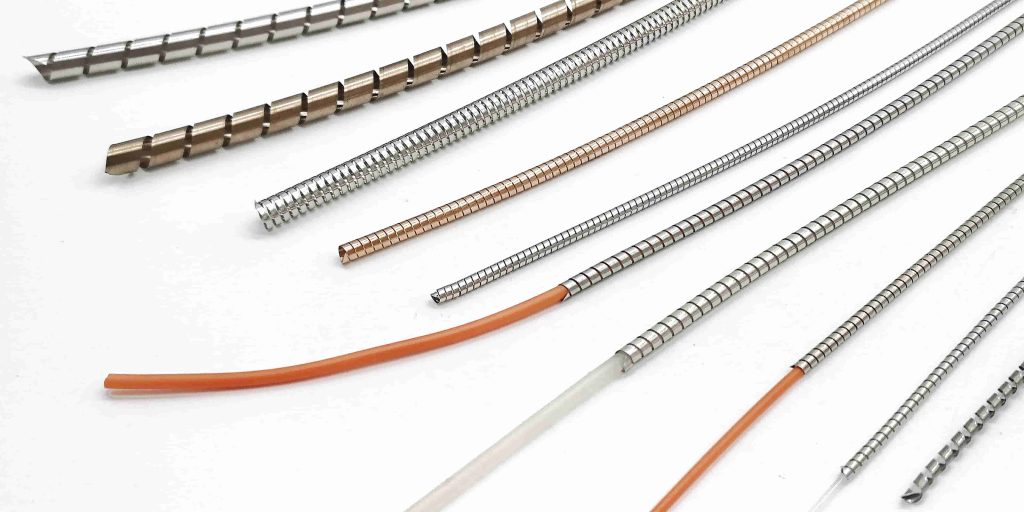
5. Additional Concerns, Issues, and Solutions
Beyond the primary concerns outlined above, several other technical challenges may arise during the design, installation, and operation of EMI shielding spiral tube liners. The following subsections address additional issues and propose robust solutions.
5.1 Thermal Expansion and Contraction Effects
Concern:
In environments with significant temperature fluctuations, differences in thermal expansion coefficients between the spiral tube liner and adjacent components can lead to gaps or misalignment. This thermal mismatch may degrade the electrical contact quality and reduce shielding effectiveness.
Solutions:
- Material Matching:
Select materials with similar coefficients of thermal expansion. Tin-plated beryllium copper, for example, can be paired with substrates that have compatible thermal properties to minimize mismatch. - Flexible Design Features:
Incorporate design features such as flexible joints or intermediary compliant layers (e.g., elastomeric buffers) to absorb thermal strains. - Thermal Cycling Tests:
Perform rigorous thermal cycling tests during product development to validate that the design maintains continuous contact and electrical conductivity across the expected temperature range.
5.2 Manufacturing Tolerances and Quality Control
Concern:
Variations in manufacturing tolerances can lead to inconsistencies in the physical dimensions and performance of spiral tube liners. Such discrepancies might affect both the compression characteristics and the overall EMI shielding performance.
Solutions:
- Advanced Manufacturing Techniques:
Employ precision manufacturing methods, such as CNC machining and laser cutting, to ensure tight tolerances and high repeatability. - Quality Assurance and Certification:
Institute strict quality control measures and obtain certifications such as ISO or MIL-STD for the production process. Consistent quality control helps to identify any deviations early in the production cycle. - Statistical Process Control (SPC):
Utilize statistical process control methods to monitor production variability and ensure that product dimensions remain within specified limits.
5.3 Chemical Compatibility and Corrosion in Harsh Environments
Concern:
In industrial, marine, or chemical processing environments, exposure to corrosive substances such as salt, acids, or industrial chemicals can compromise the integrity of the liner, leading to performance degradation over time.
Solutions:
- Surface Coating and Plating:
Use advanced surface treatments such as anodization or specialized tin plating on beryllium copper. These coatings enhance resistance to corrosive agents and extend the lifespan of the liner. - Protective Elastomeric Layers:
Integrate an outer protective layer of silicone rubber or other high-performance elastomers. This additional barrier prevents direct exposure to corrosive substances while still allowing for the necessary compression and electrical contact. - Regular Environmental Testing:
Conduct environmental exposure tests, such as salt spray and chemical immersion tests, to validate the long-term durability of the product in harsh conditions.
5.4 Vibration and Mechanical Fatigue Under Dynamic Loads <a name="”vibration”"></a>
Concern:
Many applications subject spiral tube liners to continuous vibration or cyclic mechanical loads. Over time, these dynamic stresses can lead to fatigue failure of the material, reducing the EMI shielding performance and potentially causing complete mechanical failure.
Solutions:
- Fatigue-Resistant Material Selection:
Choose materials known for their high fatigue resistance, such as high-grade beryllium copper alloys. Advanced materials often feature improved mechanical properties that are better suited to dynamic environments. - Finite Element Analysis (FEA):
Use finite element analysis during the design phase to simulate mechanical stresses and optimize the geometry of the liner. FEA helps in predicting the fatigue life and identifying potential failure points. - Damping and Vibration Isolation:
Consider incorporating damping materials or vibration isolators in the overall assembly to mitigate the impact of cyclic loads. This not only protects the spiral tube liner but also contributes to overall system reliability.
5.5 Electrical Connectivity and Contact Resistance Variability
Concern:
The reliability of EMI shielding is highly dependent on maintaining low electrical contact resistance across all interfaces. Variability in contact resistance—due to surface irregularities or inconsistent installation pressures—can lead to intermittent failures and reduced shielding performance.
Solutions:
- Enhanced Multi-Point Grounding:
Design the installation to include multiple contact points, ensuring redundancy and stable electrical pathways. For example, supplementing screw-based connections with conductive adhesives can help stabilize the contact. - Optimized Surface Finishing:
Ensure that all contact surfaces are polished and free of contaminants. A well-finished surface will maintain better conductivity over time. - Routine Electrical Testing:
Implement routine testing of contact resistance during both assembly and maintenance phases. This proactive approach helps in detecting and correcting any issues before they lead to system failure.
5.6 Integration with Other EMI Shielding Components
Concern:
In complex electronic systems, spiral tube liners must work in tandem with other EMI shielding components such as cable assemblies, filters, and enclosure seals. Ensuring compatibility and seamless integration is often a challenge.
Solutions:
- System-Level Testing:
Conduct comprehensive system-level EMI testing to verify that all components function together as intended. Testing in an integrated environment can identify interface issues that might not be apparent in isolated testing. - Standardized Interfaces:
Adopt standardized mounting and electrical interfaces to facilitate compatibility across different components and manufacturers. - Collaborative Design:
Engage with EMI shielding experts during the design phase to ensure that the spiral tube liners are well-integrated into the overall shielding strategy. Collaborative design efforts can lead to more robust and effective solutions.
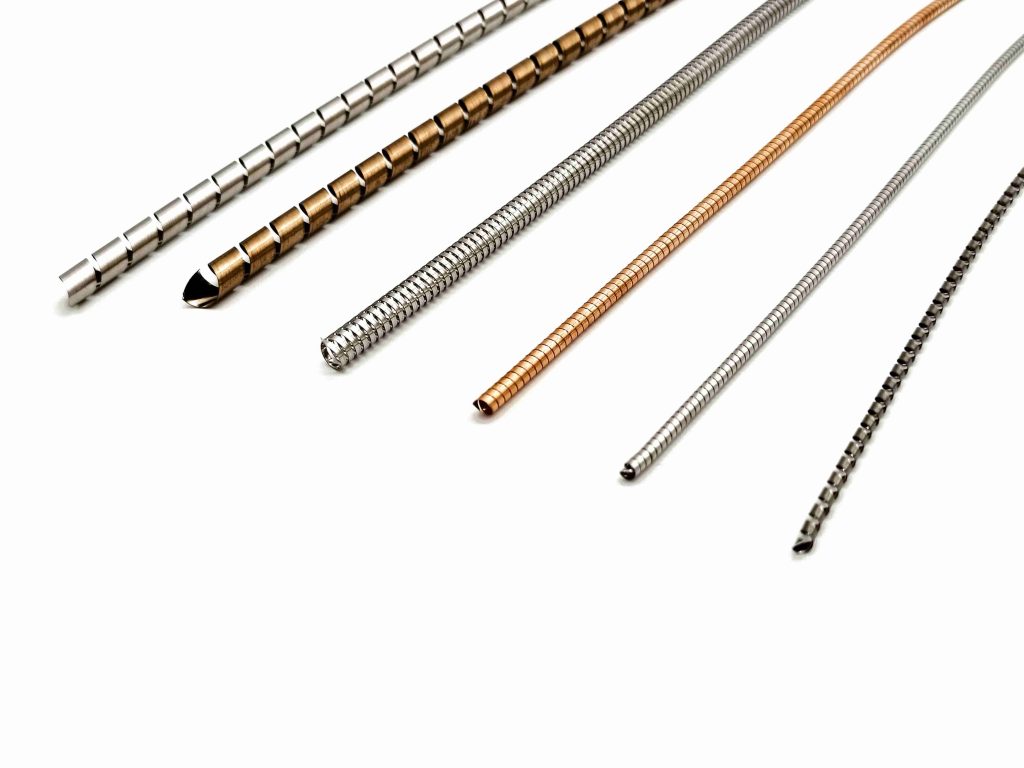
6. Industry Standards, Testing, and Certification
6.1 Overview of Key Standards
In today’s global market, EMI shielding products must meet rigorous standards to ensure reliability and compatibility. Some of the most relevant standards include:
- MIL-STD: Military standards that dictate performance requirements for critical systems.
- IEEE: Standards developed by the Institute of Electrical and Electronics Engineers, which often cover electromagnetic compatibility (EMC) and shielding.
- IEC: International Electrotechnical Commission standards that outline performance criteria for electrical equipment in various environments.
- ISO: Quality management standards that help ensure consistent manufacturing processes and product quality.
Compliance with these standards is essential for products used in aerospace, military, and high-end commercial applications. Manufacturers often conduct extensive testing to verify that their products meet or exceed these standards.
6.2 Testing Procedures and Certification Requirements
Before EMI shielding spiral tube liners are integrated into systems, they must undergo a battery of tests, including:
- Frequency Response Testing:
Measuring the shielding effectiveness across the intended frequency range (e.g., 1–10 GHz) using specialized equipment. - Thermal Cycling and Environmental Testing:
Subjecting the liners to temperature extremes, humidity, and corrosive environments to validate their long-term durability. - Mechanical Compression and Fatigue Testing:
Ensuring that the liners maintain their structural integrity and electrical continuity under cyclic loading conditions. - Electrical Continuity and Contact Resistance Testing:
Verifying that the installation and contact surfaces maintain low resistance over time.
Successful completion of these tests, along with the acquisition of relevant certifications, provides confidence that the product will perform reliably in its intended application.
7. Product Design Improvements and Future Trends
As technology advances, so too does the design and application of EMI shielding components. In this section, we explore emerging trends and potential design improvements that are shaping the future of spiral tube liners.
7.1 Advancements in Material Science
Recent breakthroughs in material science have opened up new possibilities for EMI shielding. Nanostructured alloys, advanced composites, and engineered conductive polymers are being investigated for their potential to deliver even higher shielding effectiveness while reducing weight and cost. For instance, research into modified beryllium copper alloys shows promise in further enhancing fatigue resistance and thermal stability.
7.2 Innovative Coatings and Nanomaterials
Surface coatings play a vital role in extending the lifespan and performance of EMI shielding products. Future developments may include nanocoatings that not only protect the liner from corrosion but also actively suppress EMI through engineered surface structures. These coatings could provide dual functionality—improving both the mechanical and electrical performance of the liner.
7.3 Smart Materials and Adaptive Designs
The integration of smart materials into EMI shielding components is an area of active research. Adaptive materials that change their properties in response to environmental conditions (such as temperature or humidity) could provide dynamic EMI shielding that self-adjusts to maintain optimal performance. Such innovations could revolutionize the way in which EMI shielding is implemented, particularly in applications with rapidly changing conditions.
8. 결론
In summary, EMI shielding spiral tube liners are indispensable components in the protection of high-frequency and sensitive electronic systems. Their ability to form continuous, reliable electrical contact is critical in environments ranging from commercial electronics to aerospace and military applications. This comprehensive analysis has detailed the principal customer concerns—such as shielding effectiveness, cost-performance trade-offs, installation complexity, and long-term reliability—while also addressing potential issues like over-compression, high-frequency performance fluctuations, and sliding wear.
By integrating advanced materials (such as tin-plated beryllium copper and stainless steel), employing precision manufacturing techniques, and adopting innovative design features (including dovetail groove configurations and multi-layer hybrid designs), manufacturers can overcome these challenges. In addition, emerging trends in material science, nanocoatings, and smart materials promise to further enhance the performance and versatility of EMI shielding solutions in the near future.
Ultimately, a careful evaluation of application requirements, combined with adherence to rigorous industry standards and thorough testing, ensures that the chosen spiral tube liner will deliver reliable EMI shielding and long-term durability. Whether deployed in high-frequency 5G environments, industrial settings, or critical aerospace systems, these components play a vital role in maintaining signal integrity and system performance.